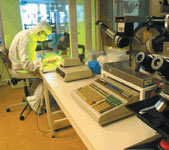Scientists build 3-D semiconductor structure that bends light the 'wrong' way

Washington, Oct 15 : A Princeton University led research team has created an easy to produce material from the stuff of computer chips that has the rare ability to bend light in the opposite direction from all naturally occurring materials.
Scientists say this startling property may contribute to significant advances in many areas, including high-speed communications, medical diagnostics and detection of terrorist threats.
The new substance is in a relatively new class of materials called “metamaterials”. They are made out of traditional substances, such as metals or semiconductors, which are arranged in very small alternating patterns that modify their collective properties.
According to Princeton electrical engineering professor Claire Gmachl, it is this approach that enables metamaterials to manipulate light in ways that cannot be accomplished by normal materials.
The new metamaterial is also three dimensional, unlike previous ones which were two-dimensional.
Prof. Gmachl said this is the first three-dimensional metamaterial constructed entirely from semiconductors, the principal ingredient of microchips and optoelectronics.
“To be useful in a variety of devices, metamaterials need to be three-dimensional,” said Prof. Gmachl.
“Furthermore, this is made from semiconductors, which are extremely functional materials. These are the things from which true applications are made,” he said.
Light waves and other forms of electromagnetic radiation bend whenever they pass from one medium to another. This phenomenon is called refraction. Lenses in reading glasses and camera also work on the principle of refraction.
While materials found in nature have positive refractive indices, the material recently invented by Princeton researchers has a negative index of refraction.
The positive refractive indices of normal materials necessitate the use of curved lenses, which inherently distort some of the light that passes through them, in telescopes and microscopes.
Flat lenses made from materials that exhibit negative refraction could compensate for this aberration and enable far more powerful microscopes that can "see" things as small as molecules of DNA.
In addition, the Princeton metamaterial is capable of negative refraction of light in the mid-infrared region, which is used in a wide range of sensing and communications applications.
Its unique composition results in less lost light than previous metamaterials, which were made of extremely small arrangements of metal wires and rings. The semiconductors that constitute the new material are grown from crystals using common manufacturing techniques, making it less complex, more reliable and easier to produce.
“Currently, the typical infrared lens is a massive object -- the setups are bulky. This new material may enable more compact mid-infrared optics because we now have a new material with an entirely new set of optical parameters in our toolkit,” said lead author and graduate student Anthony Hoffman.
The findings appear in the current issue of the journal Nature Materials. (ANI)